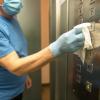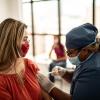
Before the Cures: Preventing Cancer
In the summer of 2016, the Centers for Disease Control and Prevention reported that cancer had surpassed heart disease as the leading cause of death in California and 21 other states.
The news was particularly distressing given increased awareness that “Up to half of cancers could be avoided if we put into practice what we know about cancers’ causes and how to prevent them,” says Alan Ashworth, president of the UCSF Helen Diller Family Comprehensive Cancer Center (HDFCCC) and senior vice president for Cancer Services at UCSF Health.
That awareness and the increased use and refinement of implementation science – the study of methods that help successfully integrate evidence-based interventions into health care and community settings – are the driving forces behind a growing number of ambitious new cancer prevention initiatives, from small, community-based projects to larger, international efforts.
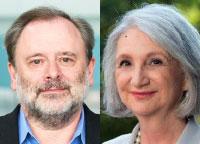 Alan Ashworth (left), Linda Sarna Nurses and nurse scientists often play a critical role.
Alan Ashworth (left), Linda Sarna Nurses and nurse scientists often play a critical role.
A Key to Cancer Prevention
“Nurses should be great champions for the behavior change needed for cancer prevention,” says Linda Sarna (PhD ’89), interim dean at UCLA School of Nursing and co-founder of Tobacco Free Nurses with UC San Francisco School of Nursing’s Stella Bialous. “We are the largest health care profession – 19 million worldwide and more than 3 million in the U.S. We are also one of the most trusted professions, and regularly have close encounters with patients in all types of settings across all socioeconomic strata.”
Bialous – an associate member of the HDFCCC, who in 2012 received the International Society of Nurses in Cancer Care Distinguished Merit Award – adds, “Numerous initiatives and studies around the world have shown that prevention does not happen on a large scale unless nurses are engaged from the very beginning, both at the decision-making and delivery levels.”
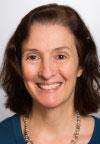 Stella Bialous Bialous and Sarna offer some important examples. Close to home, the two served as consultants on the UC Quits initiative, which aims to prevent lung and other tobacco-related cancers by developing a UC-wide tobacco cessation network and UC e-referral system with the California Smokers’ Helpline. One key piece of the effort is the integration of smoking cessation questions and treatment advice into electronic medical records across UC systems.
Stella Bialous Bialous and Sarna offer some important examples. Close to home, the two served as consultants on the UC Quits initiative, which aims to prevent lung and other tobacco-related cancers by developing a UC-wide tobacco cessation network and UC e-referral system with the California Smokers’ Helpline. One key piece of the effort is the integration of smoking cessation questions and treatment advice into electronic medical records across UC systems.
“Smoking is the single largest preventable cause of death and disease in this country, and smoking cessation has to be part of the [clinical] workflow, just like verifying blood pressure readings. We have to make time for it,” says Bialous.
“[In UC Quits] we’ve educated nurses about why this is so important and given them a place to record their interventions,” says Sarna. “The model we use reaches large numbers of nurses, uses clinically relevant educational programs and resources to increase awareness, and builds skills to transform what a good nurse does.”
Through their work with Tobacco Free Nurses, the two have worked on similar initiatives in other areas of the country. In 2007, their Helping Smokers Quit project in California, Indiana and West Virginia was the first to demonstrate that a nurse-tailored, web-based intervention significantly increased nurses’ referring their patients to the telephone quitline for smoking cessation. In 2012, they successfully delivered a modified version of that project to four hospitals in Kentucky and four in Louisiana.
“In all five states, we tailored print and web-based tobacco control materials and available resources to nurses in that particular state, accounting for the size of the nursing workforce and the smoking prevalence in that population – so that the education is relevant. We also know that different people learn in different ways, so this gives them options,” says Sarna. “This approach helped when we moved our work internationally.”
 She is referring to work that the Tobacco Free Nurses have done and continue to do in China, the Czech Republic, Poland, Hungary, Romania, Slovakia, Slovenia and other places around the world. “We’ve targeted nurses in hospitals to integrate tobacco content into patient care. In particular, we helped oncology nurses talk about tobacco use with their patients who already have cancer,” says Bialous. “There’s growing science that stopping smoking can significantly increase the lung and other cancer survival rates, often doubling the odds of survival.”
She is referring to work that the Tobacco Free Nurses have done and continue to do in China, the Czech Republic, Poland, Hungary, Romania, Slovakia, Slovenia and other places around the world. “We’ve targeted nurses in hospitals to integrate tobacco content into patient care. In particular, we helped oncology nurses talk about tobacco use with their patients who already have cancer,” says Bialous. “There’s growing science that stopping smoking can significantly increase the lung and other cancer survival rates, often doubling the odds of survival.”
Through her leadership of the International Society of Nurses in Cancer Care, Bialous is also consulting on an American Cancer Society project to prepare primary care nurses and nurse-midwives in Mexico, Brazil and Colombia to work with their patients on cervical cancer prevention and breast health.
“The key to success in all of these projects is more use of the principles of implementation science, so we can make sure these interventions become part of day-to-day nursing care,” she says.
Community-Based Interventions Rooted in Implementation Science
Implementation science was a focus for Catherine Waters long before it had a name. The Sally Bates Endowed Chair in Health Disparities at the School and an associate member of the HDFCCC, Waters has spent her career tailoring culturally sensitive interventions for preventing cancer, cardiovascular disease and diabetes for people of color in underserved communities. That’s an essential role because people in these communities have historically been left out of research studies and clinical trials despite suffering from a higher prevalence of many cancers and dying from them at a higher rate than the general population.
Waters’ NuFIT project was a community-based, participatory randomized control trial funded by the American Cancer Society that delivered nutrition and fitness interventions to African American communities throughout the Bay Area. Waters worked with a certified fitness trainer, a nutritionist, the African American Community Health Advisory Committee and local YMCAs to devise a realistic 12-week program aimed at key elements of cancer prevention, which also happen to be generally good for people’s wellness.
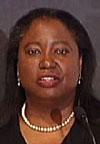 Catherine Waters “We did not want to set people up for failure,” says Waters. “So we helped people do housework in ways that would burn more calories, suggested things like getting off the bus a stop earlier to increase walking, and adapted favorite recipes to [be less carcinogenic].”
Catherine Waters “We did not want to set people up for failure,” says Waters. “So we helped people do housework in ways that would burn more calories, suggested things like getting off the bus a stop earlier to increase walking, and adapted favorite recipes to [be less carcinogenic].”
Working with a community advisory board in each area was essential, because it helped the team understand the best ways to approach and motivate people. Waters found, for example, that it was important to take time to explain what it meant to be in a control group and assuage people’s concerns about being used as guinea pigs.
The result was that after 12 weeks there were clear increases in the amount of fruits and vegetables people were eating and in their level of physical activity. The strong results confirmed for Waters the importance of forging academic-community partnerships to achieve prevention goals. She believes her own work has been much more effective thanks to her longtime partnership with the African American Community Health Advisory Committee. She also believes that if such groups, which have already demonstrated the ability to effectively implement community-based prevention efforts, had more resources, the return on investment would be enormous.
“About half of all diseases are related to lifestyles or behaviors, but our spending on prevention doesn’t reflect that understanding,” says Waters. “Perhaps that’s because people figure prevention is tied to personal responsibility – and it is – but it is also social and contextual, and we have shown that when we partner with communities, we can make a difference.”
Leveraging Community Understanding to Reduce Tobacco Use
Valerie Yerger certainly agrees. A naturopathic doctor, faculty member in the School’s Department of Social and Behavioral Sciences and project director for The LOOP – a UCSF project designed to help grantees of the California Tobacco Control Program strengthen their capacity to address the needs of their local, underserved communities – Yerger has long worked to reduce the devastating death rates from lung and other tobacco-related cancers in the African American community. She believes the failure to effectively engage community members and understand their primary concerns can hamper even the most well-intentioned prevention efforts.
 “We’ve found, for example, that in many settings, talking about how tobacco is the number one killer of black folks is not always effective because people already know that and may be more concerned about other things,” she says. “But when we talk about how their community has been targeted by the tobacco industry and this becomes a social justice issue, people’s heads tend to pick up.”
“We’ve found, for example, that in many settings, talking about how tobacco is the number one killer of black folks is not always effective because people already know that and may be more concerned about other things,” she says. “But when we talk about how their community has been targeted by the tobacco industry and this becomes a social justice issue, people’s heads tend to pick up.”
Thus, she says, researchers must learn how to listen carefully to the communities they aim to help. As one example, Yerger describes how she went to speak at a community event at a Bay Area church where one woman greeted her angrily, pointing out that the real problem in the community was gun violence. Rather than push back or point out that there were multiple problems that needed to be addressed, Yerger let the woman speak.
“When the event was over, she came up and gave me a kiss on the side of my face and said, ‘Thanks for listening. I don’t want my kids to smoke, but one of them just got shot in the ankle the other day,’” says Yerger. “It reminded me how important it is to let people voice what they have to say – and it demonstrates why community work can take a lot of time and a lot of effort.”
At the moment, Yerger’s primary focus is finding ways to reduce or eliminate the sales of menthol cigarettes and other flavored tobacco products, which tobacco companies push heavily in African American communities. Not only has Yerger’s work with Ruth Malone (who is on sabbatical) on the tobacco papers helped show that the targeting was intentional, but she and others are now also exploring why the use of menthol cigarettes is particularly devastating to African American communities. Their advocacy on this topic points out that the cooling effect of menthol makes it easier for young people to begin smoking, and that menthol may increase the uptake of other harmful substances in cigarettes, which could help explain the higher death rates from lung cancer among African Americans despite the fact that they tend to smoke less than other groups.
“It took a while to get this into the tobacco control discussion,” she says. Yet she notes that it recently came to the attention of the New York Times, and she is bringing this work to the HDFCCC’s San Francisco Cancer Initiative, or SF CAN. In the initiative, UCSF is partnering with groups throughout San Francisco to put what is known about cancer prevention into practice.
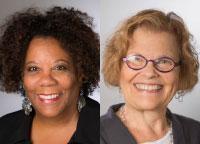 Valerie Yerger (left), Janine Cataldo “[Our part of this effort] is to get menthol cigarettes regulated, whether it’s by creating a buffer zone around schools, restricting sales to tobacco-only stores or even achieving a citywide ban,” she says. “We will use community forums to identify what will be the best for residents and what is feasible.”
Valerie Yerger (left), Janine Cataldo “[Our part of this effort] is to get menthol cigarettes regulated, whether it’s by creating a buffer zone around schools, restricting sales to tobacco-only stores or even achieving a citywide ban,” she says. “We will use community forums to identify what will be the best for residents and what is feasible.”
Framing the Messages Correctly
The community understanding that all of these researchers stress becomes especially clear when one considers how even the most effective anti-smoking messages can have an unintended effect.
“The public health strategy of denormalizing smoking has been very effective in decreasing prevalence, but the flip side has been that we too often view people who continue to smoke as crazy – as deserving of their illness – and we see a lot of negative attitudes from providers toward smokers and lung cancer patients,” says Janine Cataldo, chair of the Department of Physiological Nursing and an associate member of the HDFCCC. The result, she says, is that education efforts and cessation programs can sometimes fall on deaf ears.
“That’s why we have to be careful to blame the cigarettes and the industry – and remember to help these patients advocate for themselves in a system that might be stacked against them,” says Cataldo. “I have seen the messaging move towards that approach in the last 10 years, and that’s been helpful.”
Cataldo has infused this perspective into her own cancer prevention work. Her latest published study – in the journal Cancer Medicine – found that older smokers understand the risks of smoking and are willing to undergo annual low-dose computed tomography scans as recommended by the U.S. Preventive Services Task Force for smokers aged 55-80. These older adults also understand quite well that a clean screen is not a free pass to continue or resume smoking – a finding that has helped the National Cancer Institute (NCI) fund the pairing of smoking cessation programs with lung cancer screening clinics.
“Lung cancer is the most lethal of all cancers, and the risk of having lung cancer and other smoking-related illnesses decreases after you stop smoking and continues to decrease as more tobacco-free time passes,” says Cataldo. “But if we catch it early, the five-year survival rate [for lung cancer] can improve to more than 50 percent.”
Cataldo also recently received funding to extend another project, which uses a virtual reality application called mHealth Tool for Lung Cancer Patients to help these patients advocate for their own treatment.
On a tabletlike device, patients practice their communication skills by interacting with avatars that represent a receptionist, a medical assistant and a doctor. At the end of the “game,” they emerge with a printout that contains all the information they need, including the questions they want to ask their real doctor – and they receive feedback on how successful they were in getting what they needed.
“We hope that by allowing patients to practice and get feedback about what works, this intervention will help them speak up and get what they need to take care of themselves,” says Cataldo.
Pushing Forward Education and Research
In addition to work in clinical settings and hard-hit communities, Sarna says that schools of nursing, medicine and pharmacy need to integrate more smoking cessation content into their curricula and continue to push for smoke-free campuses, so these places can walk the walk.
“Today’s content [in health sciences schools] is not proportional to the epidemiology,” says Bialous. “The content is often focused on diseases caused by tobacco, but not on what to do about it. They do a much better job about teaching clinicians to manage hypertension and glucose levels. Maybe it’s because people who died of tobacco-caused diseases have other diagnoses (like a heart attack), and so the human suffering hasn’t resonated with practitioners to the extent that it could, but we believe it should be much more prominent, including in licensing exams.”
Similarly, many clinical trials for diseases in which tobacco may play an important role don’t account for tobacco use or fail to account for it fully. “But tobacco has an impact on treatment and outcomes, and can be responsible for certain negative side effects like mucositis, wound healing and respiratory healing,” says Sarna. That’s why she is part of an interprofessional consortium of researchers at the NCI who have made specific recommendations for collecting tobacco use data as part of all clinical cancer research.
Making Cancer Prevention Primary
“The trend globally is to integrate cancer prevention into other preventive clinical programs,” says Bialous. “So for example, in Africa, where HIV [human immunodeficiency virus] prevention has been successful, people are looking at screening these patients for cervical cancer or tobacco use or getting an HPV [human papillomavirus] vaccine. It demonstrates how a lot of cancer prevention efforts need to branch out to nontraditional cancer providers, especially primary care.”
 From her experience in many other settings, Bialous believes providers will be receptive. She describes one project in Brazil, at a busy clinic that treated patients with tuberculosis, where she helped nurses integrate smoking cessation. “We made it clear that they wouldn’t have to talk to every patient every day, but at the end of three months of treatment, they would likely end up talking to everybody, and you know what? They did it, and not one person complained about the time it took,” says Bialous. “The biggest criticism was that we didn’t require them to do in-depth cessation. Once we broke that first barrier, people understand that this is an important aspect of caring that shouldn’t be optional.”
From her experience in many other settings, Bialous believes providers will be receptive. She describes one project in Brazil, at a busy clinic that treated patients with tuberculosis, where she helped nurses integrate smoking cessation. “We made it clear that they wouldn’t have to talk to every patient every day, but at the end of three months of treatment, they would likely end up talking to everybody, and you know what? They did it, and not one person complained about the time it took,” says Bialous. “The biggest criticism was that we didn’t require them to do in-depth cessation. Once we broke that first barrier, people understand that this is an important aspect of caring that shouldn’t be optional.”
“Especially in this country, we are seeing dramatic changes,” says Sarna. “Smoking is clearly less prevalent, less acceptable, and more people understand that it is the most powerful legal addictive substance there is. That’s why delivering smoking cessation should be the Good Housekeeping Seal of approval for excellent patient care. So for example, our point of view is that nurses treating tobacco addiction should be considered as part of any assessment for Magnet hospital certification, the symbol of excellence in nursing care.”
“Also, our work internationally has shown the dangers of tobacco use and methods for quitting hasn’t gotten to other places in the world,” says Bialous. “Pregnant women in many parts of the world still smoke. Adults still smoke around small babies and children. Many nurses still smoke at high rates [30 to 40 percent], similar to nurses in the U.S. in the 1970s.”
That’s why so many of those involved in cancer prevention at UCSF believe the idea of collective impact – drawing on the commitment and integration of people who represent different groups – is the only way to make headway on something so complex.
“We are bringing new knowledge about the origins of cancer to what we know about effective prevention and early detection to make a difference at the population level,” says Ashworth. “If we can partner with government, other health systems and community groups to have a very real impact on the cancer burden in this immediate area, we believe others will follow our lead.”
Each year, UC San Francisco (UCSF) School of Nursing is ranked among the top graduate schools in the nation. Please visit our Department of Social and Behavioral Sciences, our Department of Community Health Systems and our Department of Physiological Nursing.


